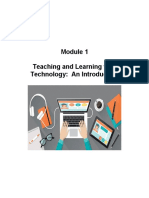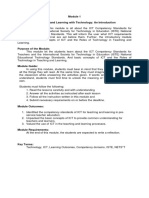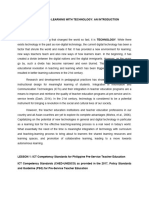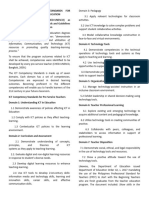Edtech 1 H. Vallota, LPT
Edtech 1 H. Vallota, LPT
Uploaded by
edgardocabarrubias02Copyright:
Available Formats
Edtech 1 H. Vallota, LPT
Edtech 1 H. Vallota, LPT
Uploaded by
edgardocabarrubias02Original Description:
Original Title
Copyright
Available Formats
Share this document
Did you find this document useful?
Is this content inappropriate?
Copyright:
Available Formats
Edtech 1 H. Vallota, LPT
Edtech 1 H. Vallota, LPT
Uploaded by
edgardocabarrubias02Copyright:
Available Formats
TECHNOLOGY FOR TEACHING AND LEARNING 1
MODULE 1-Lesson 1
Teaching and Learning with Technology: An Introduction
Module Outcomes:
1. Identified the competency standards of ICT for teaching and Learning in pre-service
teacher education
2. Unpacked the basic concepts of ICT to provide common understanding for teachers and
learners
3. Valued the use of ICT in the teaching and learning process
INRODUCTION:
If there is one thing that changed the world so fast, it is TECHNOLOGY. While there
exists technology in the past as non-digital technology, the current digital technology has been a factor
that shrunk the word and made it flat. It has provided a new environment for learning, new ways
teachers teach and also the new ways of how learners learn. In the beginning, it has created a divide
between the digital natives and the digital immigrants. However as the years go by, such divide has
become narrower and even blurred. This has led to the new educational revolution in teaching and
learning which has been triggered by technology and resulted to better learning outcomes in the 21 st
century.
Lesson 1: ICT Competency Standards for Philippine Pre-Service Teacher Education
What is competency Standards? What are the ICT standards for teaching and learning in Philippine pre-
service teacher Education?
Look at the two teachers in the pictures below. What does picture A show of the teacher? What about
picture B?
Picture A Picture B
1
Page
Edtech 1 H. Vallota, LPT
Who is better equipped to handle the 21st century learners? Teacher A or Teacher B? Why? Which of the
two teachers would you like to become when you graduate? Why?
Give reasons for choosing Picture A:
Give reasons for choosing Picture B:
ICT Competency Standards ( CHED-UNESCO) as provided in the 2017, Policy, Standards and Guidelines
( PSG ) for Pre-Service Teacher Education
-The program outcomes for teacher education degrees clearly state that every future teacher: “
demonstrate proficiency in the development and utilization of information, Communication and
Technology ( ICT ) resources in promoting quality teaching-learning process.”
To ensure that the program outcomes related to ICT shall be achieved, competencies were
identified to be developed by every pre-service teacher ( CHED_UNESCO, Bangkok, 2009. )
The ICT Competency Standards is made up of seven domains. Each domain has a set of
competencies. The competencies are expressed in desired learning outcomes. Becoming proficient in
the different competencies will enable you to handle learners of the 21 st century in your future
classroom.
THESE DOMAINS AND CORRESPONDING COMPETENCIES ARE FOUND IN THE TABLE BELOW
TABLE 1: ICT Competency Standards for Pre-service Teachers
Domain 1: Understanding ICT in Education
1.1 Demonstrate awareness of policies affecting ICT in education
1.2. Comply with ICT policies as they affect teaching-learning
1.3 Contextualize ICT policies to the learning environment
Domain 2: Curriculum and Assessment
2. 1 Demonstrate understanding of concepts, principles and theories of ICT systems as they
Apply to teaching-learning
2.2 Evaluate digital and non-digital learning resources in response to student’s diverse
2
needs
Page
2.3 Develop digital learning resources to enhance teaching-learning
Edtech 1 H. Vallota, LPT
2.4 Use ICT tools to develop 21st century skills: information media and technology skills,
Learning and innovation skills, career skills and effective communication skills
Domain 3: Pedagogy
3.1 Apply relevant technology tools for classroom activities
3.2 Use ICT knowledge to solve complex problems and support student collaborative
activities
3.3 Model collaborative knowledge construction in face to face and virtual environments
Domain 4: Technology Tools
4.1 Demonstrate competence in the technical operations of technology tools and systems
As they apply to teaching and learning
4.2 Use technology tools to create new learning opportunities to support community of
learners
4.3 Demonstrate proficiency in the use of technology tools to support teaching and
learning
Domain 5: Organization and Administration
5.1 Manage technology-assisted instruction in an inclusive classroom environment
5.2 Exhibit leadership in shared decision-making using technology tools
Domain 6: Teacher Professional Learning
6.1 Explore existing and emerging technology to acquire additional content and
Pedagogical knowledge
6.2 Utilize technology tools in creating communities of practice
6.3 Collaborate with peers, colleagues and stakeholders to access information in support
Of professional learning
Domain 7: Teacher Disposition
7.1 Demonstrate social, ethical, and legal responsibility in the use of technology tools and
resources
7.2 Show positive attitude towards the use of technology tools
These competency standards to learn and master will assure the 21st century learners in your
class of more enjoyable, creative, innovative ways in teaching and learning.
EXERCISES 1:
Identify the domain to which each given course outcome belong? ( individual )
Course Learning Outcomes Competency domain
1. Explain ICT policies and safety issues as they impact on the teaching-
learning process
2. Integrate media and technology in various content areas
3. Apply learning theories and principles in the design and development
of lessons through appropriate media and technologies for teaching
and learning
4. Formulate teaching-learning experiences and assessment tasks using
appropriate and innovative technologies
5. Demonstrate social, ethical, and legal responsibility in the use of
3
Page
technology tools and resources
Edtech 1 H. Vallota, LPT
ISTE National Educational Technology Standards for Teachers ( NETS*T )
An international organization for educational technology called International Society for
Technology in Education ( ISTE ), established standards for both teachers and students. These standards
were also referred to in the development of the Philippine ICT Competency standards which include the
following:
Standard 1: Technology Operations and Concepts
This means that the teachers demonstrate a sound understanding of technology operations and
concepts
Standard 2: Planning and Designing Learning Environment and Experiences
This standards implies that the teachers utilize the use of technology to plan and design
effective learning environments and experiences.
Standard 3: Teaching, Learning and Curriculum
Teachers should be mindful that in the implementation of curriculum plan, they have to include
strategies for applying technology to maximize student learning.
Standard 4: Assessment and Evaluation
Teachers apply technology to facilitate a variety of effective assessment and evaluation
strategies to collect and analyze data, interpret results and communicate findings to improve
instructional practice and maximize student learning.
Standard 5: Productivity and Professional Practice
Teachers use technology to engage in on-going professional development and lifelong learning
in support of student learning, increase productivity and to build community of learners.
Standards 6: Social, Ethical, Legal and Human Issues
Teachers understand the social, ethical, legal and human issues surrounding the use of
technology in support of student learning who come from diverse background, affirm diversity, promote
safe and healthy use of technology resources and facilitate access to technology resources for all
students
LIKEWISE, ISTE also developed standards needed for students. These standards will be used as a
guide by teachers to plan technology-based activities in which students achieve success in learning,
communication and life skills.
ISTE NATIONAL EDUCATIONAL TECHNOLOGY STANDARDS FOR STUDENTS ( NETS*S )
4
From how technology teachers facilitate learners, outcomes of student learning should indicate
Page
that the following standards have been complied with.
Edtech 1 H. Vallota, LPT
Standard 1: Creativity and Innovation
This standard will produce students who demonstrate creative thinking, construct knowledge,
develop innovative products and processes using technology from existing knowledge.
Standard 2: Communication and Collaboration
This standard requires students to use digital media and environments to communicate and
work collaboratively to support individual learning and contribute to the learning of others. This includes
the use of variety of media and formats for global awareness with learners from other cultures.
Standard 3: Research and Information Fluency
Students are expected to apply digital tools to gather, evaluate and use information and plan
strategies for inquiry. This standard expects the students to locate, organize, analyze, evaluate,
synthesize and ethically use information from a variety of sources and media.
Standard 4: Critical Thinking, Problem-Solving and Decision Making
This standard expects the students to use critical thinking skills to plan and conduct research,
manage projects, solve problems and make informed decisions using appropriate digital tools.
Standard 5: Digital Citizenship
It is required by this standard that every technology student becomes a digital citizen who
demonstrate ethical and legal bahaviour, exemplified by the practice of safe, legal and responsible use
of information. Further, the student exhibits positive attitude towards the support of technology for
collaboration, learning and productivity as a digital citizen…
Standard 6: Technology Operations and Concepts
Sound understanding of technology concepts, system and operation is a standard that students
should comply with. They too, are expected to further transfer current knowledge to learning of new
technologies.
As pre-service teacher education students now, you will have to master the knowledge and skills
( Learning to Know ) for the standards for students. However since you will become ( Learning to
Become )future teachers. As a whole standards for teachers and students look at the table below:
A. ISTE STANDARD FOR TEACHERS B. ISTE STANDARD FOR STUDENTS
1. Technology Operations and Concepts 1. Creativity and Innovation
2. Planning and Designing Learning 2.Communication and Collaboration
Environment and Experiences
3. Teaching, Learning and Curriculum 3. Research and Information Fluency
4. Assessment and Evaluation 4.Critical Thinking, Problem-Solving &
Decision Making
5. Productivity and Professional Practice 5. Digital Citizenship
5
Page
6. Social, Ethical, Legal, and Human Issues 6. Technology Operations and Concepts
Edtech 1 H. Vallota, LPT
Task 1: Group Activity
Locate in CMO 74 or 75 s. 2017. Review the competencies and read the corresponding
Performance indicators under each 7 Domains. With your group, identify one performance Indicator for
each cluster that you consider as most important and that you are excited to do. Identify also one
performance Indicator that you consider least important and that you are not excited to do. Place your
answer on the matrix below.
ICT Domain Performance Indicator Most Important for Performance Indicator Least Important for
us to do us to do
Domain 1
Domain 2
Domain 3
Domain 4
Domain 5
Domain 6
Domain 7
Task 2:
1. This will be done by group
2. Use the survey instrument on the use of ICT in the Classroom found below
3. Ask permission from the school head or principal that you will conduct a survey
4. With your group, conduct a survey of at least 20 elementary teachers for those who will teach
from k to grade 6 or 20 highschool teachers for those who will be teaching from grade7-12
The Survey on the use of ICT in the Teaching and Learning for Teachers
Dear Teachers, please mark check ( / ) your answer to the following questions YE NO
found below. S
1. Do you use technology in your teaching?
2. Are you aware of policies that guide you in the use of ICT?
3. Do you use non-digital learning resources in your teaching?
4. Do you develop digital resources for your learners?
5. Do you use technology tools for classroom activities?
6. Are you expert in the use of technology tools for teaching?
7. Do you have facilities to use of technology tools in your classes?
8. Are you aware of ethical and legal responsibilities in the use of ICT tools?
9. Are your students learning better with the use of technology tools?
10. Do you enjoy using ICT tools in your teaching?
5. Consolidate your data.
1. How many answered YES or NO for each item? What percent is Yes? NO?
2. Which of the 10 items has more Yes than NO answers? Rank the items with more Yes and
6
Page
rank items with more No.
3. What meaning can you derive from your results? Report your answer via zoom.
Edtech 1 H. Vallota, LPT
7
Page
Edtech 1 H. Vallota, LPT
You might also like
- The Great Bear S3Document17 pagesThe Great Bear S3S TANCREDNo ratings yet
- ICT Competency Standards For Pre-Service TeachersDocument1 pageICT Competency Standards For Pre-Service TeachersWINA GONZALESNo ratings yet
- Module 1 Teaching and Learning With Technology An Introduction 2Document10 pagesModule 1 Teaching and Learning With Technology An Introduction 2Trexie AmarNo ratings yet
- ttl1 MidtermDocument62 pagesttl1 MidtermJo Michael Flores Agarma100% (1)
- Course Pack Prof Ed. 10 Module 1Document12 pagesCourse Pack Prof Ed. 10 Module 1Ever Shekhaina-XavierNo ratings yet
- Prof Ed 5Document21 pagesProf Ed 5autumntuazon25No ratings yet
- SG 1Document8 pagesSG 1Mariane EsporlasNo ratings yet
- EDUC206-MODULES ReviewerDocument48 pagesEDUC206-MODULES ReviewerIvy Novero SibuloNo ratings yet
- Module 1 Lesson 1Document5 pagesModule 1 Lesson 1renaedusma29No ratings yet
- MODULE 1-Task 1Document5 pagesMODULE 1-Task 1Relan MortaNo ratings yet
- Technology For Teaching and Learning 1 Module 1Document54 pagesTechnology For Teaching and Learning 1 Module 1Danley Carandang100% (5)
- TTL1 Lesson-1 Topic-1Document5 pagesTTL1 Lesson-1 Topic-1pamevaleriemNo ratings yet
- LESSON 1 Teaching and Learning With TechnologyDocument6 pagesLESSON 1 Teaching and Learning With TechnologyJan Beau-J NapalanNo ratings yet
- M1 - Intro To Technology For Teaching and Learning 1Document15 pagesM1 - Intro To Technology For Teaching and Learning 1Renz E. FerreraNo ratings yet
- TTL 1 Lesson 1Document12 pagesTTL 1 Lesson 1ere chanNo ratings yet
- 1 Teaching and Learning With Technology An IntroductionDocument31 pages1 Teaching and Learning With Technology An Introductionerickatirao32No ratings yet
- EDUC 30033 Module 1 Lesson 1Document6 pagesEDUC 30033 Module 1 Lesson 1Uzumaki NarrutoNo ratings yet
- Technology For Teaching and Learning 1 (Topic 1)Document11 pagesTechnology For Teaching and Learning 1 (Topic 1)Blessy MartinNo ratings yet
- Teaching & Learning With Technology First TopicDocument16 pagesTeaching & Learning With Technology First TopicShairon Palma100% (1)
- Lecture 1:technology For Teaching and Learning 1Document120 pagesLecture 1:technology For Teaching and Learning 1Imelda Nadiahan100% (1)
- Prof. Ed. 3 M1L1Document7 pagesProf. Ed. 3 M1L1Jason San PidroNo ratings yet
- TTL1 W1Document7 pagesTTL1 W1Leah DiongcoNo ratings yet
- Unit 1 Introduction To Teachnology and LearningDocument62 pagesUnit 1 Introduction To Teachnology and LearningAngela MarcosNo ratings yet
- Unit 1 TTLDocument6 pagesUnit 1 TTLJanviel BangsalNo ratings yet
- Introduction To Technology For Teaching and Learning KissieDocument14 pagesIntroduction To Technology For Teaching and Learning KissieAndrew C. BrazaNo ratings yet
- Cte-Ped08-Babistaae Module - 112857Document101 pagesCte-Ped08-Babistaae Module - 112857Justine Lawrenz BaracenaNo ratings yet
- Module in Teaching and Learning 1 CHAPTER 1 1Document28 pagesModule in Teaching and Learning 1 CHAPTER 1 1Michel Jay Arguelles EspulgarNo ratings yet
- Review On TTL 1Document12 pagesReview On TTL 1penosajoy98No ratings yet
- Unit 1. Introduction To Technology For Teaching and LearningDocument18 pagesUnit 1. Introduction To Technology For Teaching and LearningErika RamosNo ratings yet
- Reviewer Ed107Document16 pagesReviewer Ed107Margareth De VillaNo ratings yet
- Edck 5 Week 1 4Document48 pagesEdck 5 Week 1 4Marivic MiradorNo ratings yet
- Module 1 Lesson 1 Ict Competency Standards For Philippine Pre Service Teacher EducationDocument7 pagesModule 1 Lesson 1 Ict Competency Standards For Philippine Pre Service Teacher EducationaustenejeremiecanamaNo ratings yet
- Lesson 1 ICT Competency Standards For Philippine PreDocument5 pagesLesson 1 ICT Competency Standards For Philippine PreFrederick Domicillo100% (1)
- 1.teaching and Learning With TechnologyDocument4 pages1.teaching and Learning With TechnologyMelissa TadleNo ratings yet
- ICT Competency Standards (CHED-UNESCO), Policy, Standards and Guidelines (PSG) For Pre-Service Teacher EducationDocument5 pagesICT Competency Standards (CHED-UNESCO), Policy, Standards and Guidelines (PSG) For Pre-Service Teacher EducationPrincess Veah IlaoNo ratings yet
- Lecture Notes Week 2 4Document8 pagesLecture Notes Week 2 4Wia Cristy EgotNo ratings yet
- Pec 8 Ilk PrelimDocument19 pagesPec 8 Ilk PrelimAlma Guillermo EyagoNo ratings yet
- Technology For Teaching and Learning 1 - Lesson 1 3Document13 pagesTechnology For Teaching and Learning 1 - Lesson 1 3Jerry F. Abellera Jr.No ratings yet
- TTL 1-Lesson 1Document14 pagesTTL 1-Lesson 1Jenny HermosaNo ratings yet
- Module 1 Lesson 1Document16 pagesModule 1 Lesson 1Jenny EscotoNo ratings yet
- Prof. Ed. 108 SG1-1Document6 pagesProf. Ed. 108 SG1-1Fate VargasNo ratings yet
- Reviewer in Ed 107 Technology For Teaching and LearningDocument14 pagesReviewer in Ed 107 Technology For Teaching and LearningJesille May Hidalgo Bañez100% (1)
- Module 1 Lesson 1Document5 pagesModule 1 Lesson 1Glaidine Quiño DiamolaNo ratings yet
- Educ 6Document9 pagesEduc 6Regine QuijanoNo ratings yet
- Garcia, Jed D. Bee-Ege II-1 - ttl1 - Module 1-30pointsDocument8 pagesGarcia, Jed D. Bee-Ege II-1 - ttl1 - Module 1-30pointsJed GarciaNo ratings yet
- Lesson 1Document8 pagesLesson 1CATHERINE BESNo ratings yet
- Activity 1Document5 pagesActivity 1espanillojomari27No ratings yet
- Teaching Social StudiesDocument6 pagesTeaching Social Studiessarsarah41No ratings yet
- Lesson Handout - EDUC 85 - Lesson 1 ICT Competency Standards For Philippines PRe Service Teacher EducationDocument5 pagesLesson Handout - EDUC 85 - Lesson 1 ICT Competency Standards For Philippines PRe Service Teacher EducationPATRIA, MARIA JENICANo ratings yet
- ICT Competency Standards CHED UNESCODocument11 pagesICT Competency Standards CHED UNESCOshielaNo ratings yet
- Module 1-Lesson 1Document8 pagesModule 1-Lesson 1Kel LumawanNo ratings yet
- Technology For Teaching and Learning 1 (Topic 1)Document8 pagesTechnology For Teaching and Learning 1 (Topic 1)Blessy MartinNo ratings yet
- Module 1 Technology For Teaching and LearningDocument4 pagesModule 1 Technology For Teaching and LearningLovely Jean PerezNo ratings yet
- Module 1a Educ106aDocument4 pagesModule 1a Educ106aQueenie Ashley SaludezNo ratings yet
- TTL1 - UNIT 1 and 2Document24 pagesTTL1 - UNIT 1 and 2Al LaurioNo ratings yet
- Lesson 1Document29 pagesLesson 1John Patrick Arcite100% (2)
- Class Orientation TTL 1Document29 pagesClass Orientation TTL 1Irish Jane TabelismaNo ratings yet
- SC TTL Week 1Document30 pagesSC TTL Week 1amlsanjuanNo ratings yet
- Module 1 Lesson 1 Teaching and Learning With TechnologyDocument4 pagesModule 1 Lesson 1 Teaching and Learning With TechnologyJOSEHP FRADEJASNo ratings yet
- Module 1Document44 pagesModule 1Katrina JabienNo ratings yet
- Enhanced Road Assessment FAQsDocument3 pagesEnhanced Road Assessment FAQsDaniyal AzmatNo ratings yet
- Vistas #18Document16 pagesVistas #18vvaccountsNo ratings yet
- Praxis Core Exam AnalysisDocument2 pagesPraxis Core Exam Analysisapi-429281659No ratings yet
- Content Knowledge and PedagogyDocument5 pagesContent Knowledge and PedagogyNICHOLE DIANNE DIME. DIAZNo ratings yet
- Cloud Lesson PlanDocument2 pagesCloud Lesson Planapi-241808531No ratings yet
- Saeindia Collegiate Club Guidelines NewDocument22 pagesSaeindia Collegiate Club Guidelines NewaadhithyarajasekaranNo ratings yet
- Festo Didactic Overview Brochure 2009Document91 pagesFesto Didactic Overview Brochure 2009marina890416No ratings yet
- The Goals of Classroom ManagementDocument4 pagesThe Goals of Classroom ManagementmunazzaNo ratings yet
- Department of Education: Office of The Undersecretary For Curriculum and InstructionDocument29 pagesDepartment of Education: Office of The Undersecretary For Curriculum and InstructionEvelynNo ratings yet
- Quantum Sush Repaired)Document45 pagesQuantum Sush Repaired)akanxa1987100% (1)
- Theresa Tiscia ResumeDocument2 pagesTheresa Tiscia Resumeapi-157384674No ratings yet
- Trainers Methodology DemonstrationDocument14 pagesTrainers Methodology DemonstrationMaria Angellie S. Bellido - EramisNo ratings yet
- UNIT 01 Video WorksheetsDocument2 pagesUNIT 01 Video WorksheetsGustavo Reges50% (2)
- Electromagetics Matlab ProjectDocument11 pagesElectromagetics Matlab ProjectSaloni AgarwalNo ratings yet
- Teachers GuideDocument17 pagesTeachers Guideapi-281256997No ratings yet
- Expert - Guide To Leveraged Learning - InyDocument4 pagesExpert - Guide To Leveraged Learning - InyTechCEL LLCNo ratings yet
- B.A (Lovely Professional University)Document4 pagesB.A (Lovely Professional University)MangeshNishadNo ratings yet
- Oral CompetenceDocument17 pagesOral CompetenceCyrill MironNo ratings yet
- Annotated ReadingDocument5 pagesAnnotated ReadingMsWintermyerNo ratings yet
- Kylee Williams - Personification Lesson Plan Draft 2Document5 pagesKylee Williams - Personification Lesson Plan Draft 2api-272826545No ratings yet
- Didactic Planning - Innovations-Last OneDocument4 pagesDidactic Planning - Innovations-Last OneHQUIROS090No ratings yet
- Equity-In-Education Certificate of Achievement V6flvpyDocument2 pagesEquity-In-Education Certificate of Achievement V6flvpyapi-441221942No ratings yet
- Bus - Boycott - QuizDocument13 pagesBus - Boycott - Quizapi-503236378No ratings yet
- Grand Masters Package (GMP)Document1 pageGrand Masters Package (GMP)Shashank Tiwari29% (7)
- 8th Grade Math SyllabusDocument4 pages8th Grade Math Syllabusapi-262510524No ratings yet
- Behaviorism Antecedent InfluencesDocument12 pagesBehaviorism Antecedent InfluencesKarin Paula100% (1)
- Module On Theories of MotivationDocument4 pagesModule On Theories of MotivationJohn Lawrence A. BellenNo ratings yet
- 11 Key Areas Evaluation ToolDocument10 pages11 Key Areas Evaluation Toolpinoybsn26No ratings yet
- Informal Lesson Plan - Grouchy LadybugDocument3 pagesInformal Lesson Plan - Grouchy Ladybugapi-249409482100% (1)

























































































